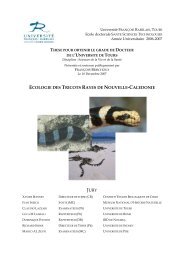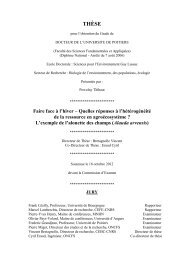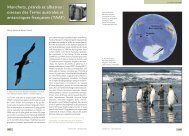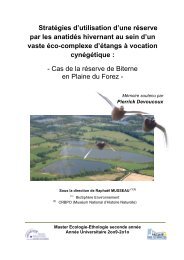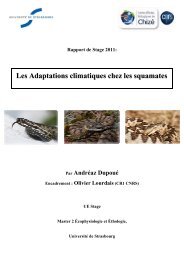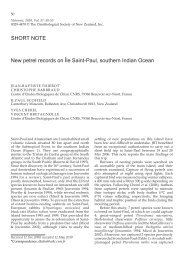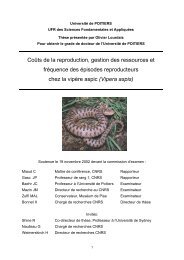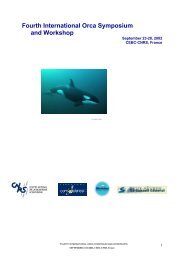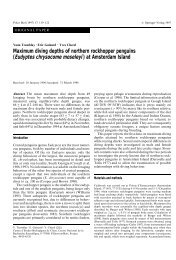Forçage environnemental et prédateurs marins ... - Cebc - CNRS
Forçage environnemental et prédateurs marins ... - Cebc - CNRS
Forçage environnemental et prédateurs marins ... - Cebc - CNRS
Create successful ePaper yourself
Turn your PDF publications into a flip-book with our unique Google optimized e-Paper software.
marine predators (Mangel 1993; Weimerskirch, Brothers &<br />
Jouventin 1997). Conservation measures such as seasonal<br />
closure or technical improvements have been implemented<br />
to minimize bycatch in several ocean regions (Kraus <strong>et</strong> al.<br />
1997; Robertson <strong>et</strong> al.<br />
2006). Despite this progress, the population-level<br />
and ecosystem effects of bycatch remain poorly<br />
understood.<br />
Several studies worldwide have documented an impact of<br />
climate on population dynamics through local weather and<br />
large-scale climatic phenomena (Stens<strong>et</strong>h <strong>et</strong> al.<br />
2002; Dulvy<br />
<strong>et</strong> al.<br />
2008). Both climate and fisheries can affect the dynamics<br />
of marine predators, and effective management actions<br />
rely on an understanding of the respective magnitude of<br />
the population-level effect of these threats and their respective<br />
effects on specific life-history stages. However, very few<br />
studies have disentangled the effects of fisheries and climate<br />
on vital rates of species affected by bycatch (Nel <strong>et</strong> al.<br />
2003;<br />
Frederiksen <strong>et</strong> al.<br />
2004; Rolland, Barbraud & Weimerskirch<br />
2008), and the direct link b<strong>et</strong>ween fisheries and observed<br />
population declines has been hard to establish (Guen<strong>et</strong>te <strong>et</strong> al.<br />
2006). Our understanding of the consequences of fisheries<br />
bycatch on non-targ<strong>et</strong> species has improved for marine<br />
megafauna (albatrosses, whales), but less charismatic species<br />
have received less attention, although some are caught in<br />
large numbers in fisheries, and changes in their abundance<br />
may have important ecological consequences (Lewison <strong>et</strong> al.<br />
2004). Efficient mitigation measures implemented to reduce<br />
bycatch often increase costs for fishing companies, which<br />
may prevent the implementation of the mitigating technology<br />
in the fisheries of developing nations (Lewison <strong>et</strong> al.<br />
2004). In<br />
addition, funds allocated to reduce mortality for some nontarg<strong>et</strong><br />
species may be at the expense of other non-targ<strong>et</strong> species<br />
with higher conservation concerns. In this context, bycatch<br />
can be considered as exploited populations (Lebr<strong>et</strong>on 2005),<br />
and the theor<strong>et</strong>ical basis for harvesting renewable resources<br />
can be utilized to explore the sustainability of the dynamics<br />
and interactions b<strong>et</strong>ween natural mechanisms and bycatch.<br />
The logic here is that it might not be necessary to reduce<br />
bycatch to zero but to reduce bycatch to a sustainable level relative<br />
to the dynamics of the population affected by bycatch<br />
(Williams, Nichols & Conroy 2002).<br />
The white-chinned p<strong>et</strong>rel Procellaria aequinoctialis Linnaeus<br />
1758 population is an interesting case study in the<br />
context of bycatch problems since it is by far the most common<br />
seabird species killed by fishing activities in the Southern<br />
Ocean (Robertson <strong>et</strong> al.<br />
2006). Large numbers are killed in<br />
longline fisheries targ<strong>et</strong>ing Patagonian toothfish Dissosticus<br />
eleginoides Smitt 1898 (Nel, Ryan & Watkins 2002; Favero<br />
<strong>et</strong> al.<br />
2003) and hake Merluccius spp. (Barnes, Ryan & Boix-<br />
Hinzen 1997). As many as 94% of seabirds estimated killed in<br />
the Kerguelen and Croz<strong>et</strong> archipelagos toothfish longline<br />
fisheries since 1997 were white-chinned p<strong>et</strong>rels (Weimerskirch,<br />
Capdeville & Duhamel 2000; Delord <strong>et</strong> al.<br />
2005). Although it<br />
is estimated that hundreds of thousands of pairs are breeding<br />
worldwide (Brooke 2004), d<strong>et</strong>ailed and compl<strong>et</strong>e surveys<br />
are lacking on the major breeding grounds. The species was<br />
moved from an IUCN listing of Lower Risk/Near Threatened<br />
Effect of climate and fisheries on p<strong>et</strong>rel dynamics<br />
© 2008 The Authors. Journal compilation © 2008 British Ecological Soci<strong>et</strong>y, Journal of Applied Ecology,<br />
45,<br />
1460–1467<br />
1461<br />
to Vulnerable in 2000 (Birdlife International 2000) following<br />
recent declines observed at sea (Woehler 1996) and at a<br />
breeding colony in South Georgia (Berrow, Wood & Prince<br />
2000), combined with tens of thousands of individuals caught<br />
in fisheries each year. These declines may be related to fishing<br />
activities around their breeding and non-breeding grounds,<br />
but changes in demographic param<strong>et</strong>ers in relation to climate<br />
fluctuations have never been investigated in this species. In<br />
addition, because breeding population sizes and demographic<br />
param<strong>et</strong>ers are poorly known, and because there is little information<br />
on the at-sea distribution during the non-breeding<br />
season, it has been difficult to estimate the impact of fisheries<br />
related mortality on the dynamics of the white-chinned p<strong>et</strong>rel<br />
population.<br />
Here we use population survey data, capture–mark–recapture<br />
(CMR) m<strong>et</strong>hods, matrix population modelling and a<br />
m<strong>et</strong>hod based on demographic invariants to investigate the<br />
effect of climate and fisheries on the demography of whitechinned<br />
p<strong>et</strong>rels at Croz<strong>et</strong> archipelago, Southern Indian Ocean.<br />
The aims of this study are: (i) to estimate the demographic<br />
param<strong>et</strong>ers and to d<strong>et</strong>ermine the relative impact of climate and<br />
fisheries on the vital rates using a 20-year data s<strong>et</strong> of life history<br />
data; (ii) to develop a matrix population model allowing us<br />
to explore the impact of climate and fisheries on the population<br />
rate of increase ( λ);<br />
(iii) to validate this model using<br />
population survey data; (iv) to assess wh<strong>et</strong>her the fisheriesinduced<br />
additional source of mortality is sustainable or not<br />
for this population; and (v) to conduct population projections<br />
with different levels of fishing effort and climate change.<br />
M<strong>et</strong>hods<br />
SPECIES<br />
ECOLOGY,<br />
STUDY<br />
AREA<br />
AND<br />
FIELD<br />
DATA<br />
White-chinned p<strong>et</strong>rels nest in more of less aggregated burrows, forming<br />
relatively dense colonies (Brooke 2004). Visits to the colonies<br />
start before dusk and continue during the first part of the night. Birds<br />
r<strong>et</strong>urn to colonies in September and lay their single egg in November.<br />
Chicks hatch in January and fledge in April. During breeding, males<br />
and females alternate foraging trips at sea and feed on fish, krill and<br />
squid (Ridoux 1994; Catard, Weimerskirch & Cherel 2000).<br />
Fieldwork was conducted at Possession Island (46°<br />
25′<br />
S, 51°<br />
45′<br />
E;<br />
c.<br />
17 × 13 km), Croz<strong>et</strong> archipelago (Supplementary Material Fig. S1),<br />
b<strong>et</strong>ween 1983 and 2004. Since 1985, 75 burrows have been inspected<br />
annually during breeding. Every year, all adult birds captured in<br />
the study burrows were marked with a stainless steel band during egg<br />
incubation, and all chicks were marked just before fledging. Two visits<br />
during the early incubation period (December), one visit at hatching<br />
(January) and one visit just before fledging (March) allowed each<br />
marked individual to be identified and its breeding success measured.<br />
The total number of burrows and breeding pairs on Possession<br />
Island and the Croz<strong>et</strong> archipelago were estimated in 1983 and 2004<br />
(Supplementary Material Appendix S1).<br />
POPULATION<br />
MODELLING<br />
We chose a simple age/stage structured matrix population model<br />
(Supplementary Material Appendix S2) as this allowed us to assess<br />
the importance of the basic demographic param<strong>et</strong>ers without going



